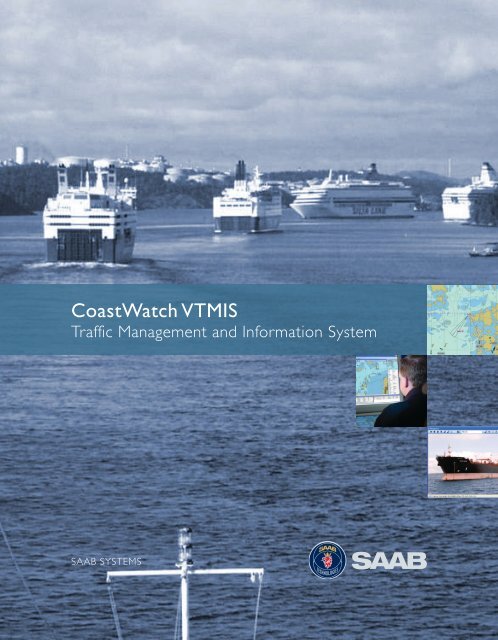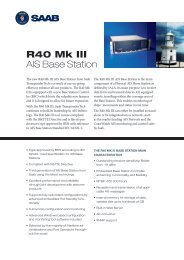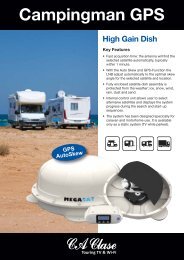CoastWatch VTMIS - CA Clase
CoastWatch VTMIS - CA Clase
CoastWatch VTMIS - CA Clase
- No tags were found...
You also want an ePaper? Increase the reach of your titles
YUMPU automatically turns print PDFs into web optimized ePapers that Google loves.
<strong>CoastWatch</strong> <strong>VTMIS</strong>Traffic Management and Information SystemSAAB SYSTEMS
Operator WorkstationThe vessel traffic situation is presented on an electronicchart display that is capable of displaying:• Chart information• System tracks (from radar, AIS and othersources)• Radar plots and radar video• Sensor information• Custom chart objects (areas, lines, points)• Routes• CCTV videoThe presentation content and layout is configurableso that information overflow and cluttering isprevented making it intuitive and easy to use. Thesettings of the presentation views can be defineduniquely for each operator.<strong>CoastWatch</strong> <strong>VTMIS</strong> presentation system
Work flow supportIntegrated support for work flow by the use ofalarms and reports. The system provides the operatorwith easy to use tools which support the workflowof a VTS. These tools allow the operators to easilysave the information reported by mariners duringtheir movement within the VTS area. To enter thesereports the operator can simply click on the correspondingtrack/vessel in the chart and select to entera specific report. Examples of standard reports are:• Pre-entry report• Entry report• Position report• Arrival report• Pre-departure report• Departure report• Exit report• Anchorage report• Pilot reportWhen entering these reports, the system automaticallyprovides all the information it has regarding thevessels current status, e.g. position, direction, time ofreport etc. in order to minimize the workload of theoperator.If the integrated workflow tools are utilised, thesystem can provide the operator with a better overviewof the traffic situation. This is achieved throughthe use of special symbols in the chart window, e.g.if a vessel is carrying dangerous cargo; alarms whichare raised if vessels with certain reported propertiesviolate some rule, e.g. vessel with dangerous cargopassing through a sensitive area; special lists for differentcategories of vessels. Typical lists are:• Arrivals (ships that have provided a pre-entryreport)• Departures (vessels that have provided a predeparturereport)• Vessels under Surveillance (all vessels within theVTS area, which are actively monitored by theVTS)• Incident reportH1: Pre-entryH2: TrackingidentificationH3: EntryH4: Pilot boardingH5: Vessel handoverH6: PositionH7: Vessel handoverH8: ArrivalVessel management workflow
Charts and chart managementThe system supports S57/63 charts, raster charts/imagesand custom charts. We have developed ourown chart engine in order to achieve maximumperformance and flexibility. This also ensures that wetogether with the customer easily can introduce newfunctions in the chart system.The chart handling is hardware acceleratedwhich enables the operator to very quickly zoom andpan the charts.The management of the charts in the system ishighly flexible. It includes configuration functions,e.g. to control by a keystroke the detail levels of thechart display.Custom chart objects<strong>CoastWatch</strong> <strong>VTMIS</strong> supports user defined chart objects;areas, lines, points and routes. These are storedcentrally and distributed to other operators withinthe system.Track managementReal-time tracks are generated using the Saab highqualityVessel Tracker Handler (VTH), derived fromour military solutions. The system primarily usesplot-based data fusion, which gives the most reliabledetection results. At the same time it is possible touse tracks from single radar trackers. The VTH isplaced at the control centre. This tracker can handlemultiple radars and other types of sensors such asAIS. Tracks are fused in to one system track which isdisplayed in system.The presentation interface allows for a largenumber of track management operations such as:• Display track status• View individual track components of a systemtrack• Manual track creation• Swapping tracks• Custom track labelling etc.Custom chart objects
RadarSaab can supply a variety of radars, depending onuser requirements, or connect to existing radars.Each of the radar sites will be equipped with a radarwith either single or dual transceivers, a radar maintenanceconsole PC and Radar Extractor by Saab,hosted in a separate PC or in some situations in ashared PC. Both PC’s are connected to one display,keyboard and mouse through a KVM Switch.The radar site can have an Uninterruptible PowerSupply (UPS). The UPS will shut down the equipmentin a secure way if the battery expires. The UPScan be controlled using the LAN connection toreboot the radar and the other site equipment.The radar operation can be configured and controlledon-site using the radar extractor PC and themaintenance console or remote by using the SystemManagement Subsystem. Some of the radar functionare also available from the operator workstations.AISThe AIS subsystem comprises one or several AISbase stations, normally configured as hot standby.A typical site installation is shown below.AIS base station site equipmentExample of radar equipment and interconnection
Other sensors<strong>CoastWatch</strong> <strong>VTMIS</strong> supports a variety of other sensors.CCTV, MetHydro, Direction finders etc. can besupplied to meet specific customer requirements.Sensor controlThe system has support for a large set of sensors andextensive sensor monitor and control, both in a chartand in a sensor specific controls. The CCTV cameracan for instance be directed and zoomed towards aship by clicking on the target on the chart.Communication subsystemThe communications subsystem supports the followingfunctions:• Contacts (Operators, other VTS, Pilots, Tugs,Agents etc.)• Messaging (instant messages and AIS messages)• E-mail• SMS• Desktop sharing• Hand-over of vessels between sectors• Incoming AIS messages to responsible operatorRoute managementRoute management and track route association canbe handled in the <strong>CoastWatch</strong> <strong>VTMIS</strong>. A ship canbe associated with a route and alarms be given ondeviation. The system can predict ETA, based on aroute definition.Rule managementRules can be set on vessels or on geographicalobjects. They are typically connected to predefinedareas. The system includes an advanced rule enginewhich provides decision support to the operators.Examples of available rules are:• Inside area• Entering/Leaving area• Crossing line• Approaching/Leaving point• Speeding• Proximity• Depth limitations• Carrying dangerous cargo• Track lostRule editor
Rules can be combined using logical operations toform complex sets of rules, e.g. if a ship with dangerouscargo enters the harbour and exceed a certainspeed. Specific actions can be associated with a rule.The action determines what happens when therule is broken, examples of actions are;• Generate an alarm• Generate a report• Send a message, etc.The system includes decision support by the use ofareas, alarms and rulesAlarm subsystemOperational alarms are initiated on violations ofdefined rules and are displayed in an alarm window.Record and replayThe record function is dimensioned to meet customer’srequirements for readily available data storage aswell as thinned data for a long term archiving.A replay scenario can be exported to a replay fileor a .AVI file.Synchronized recording and replay capabilitiesfor all core data sources in the systems;Sensor information:• Compressed radar video• Plots• Tracks (Radar, AIS, System tracks)• CCTV images• Hydrometeo• RDF etc.Operational events:• Operators actions• Alarms• Voice communicationSystem events:• Systems failures• Configuration changesVessel information:• Vessel identifications• Vessel statusAlarm window
Vessel information systemThe advanced Vessel Information System is integratedinto the graphical user interface. The Vesseldatabase stores external data, custom data andVTS generated reports. Data can be imported fromexternal sources (e.g. Lloyds) or can be added by theoperator (e.g. images).Detailed vessel information is displayed simplyby clicking on the target.Vessel information formCCTV handlingThe CCTV can automatically track a target by clickingon the target in the chart view and choose “Trackwith CCTV”. Photos can be taken of ships andstored in the vessel database. The system supportscontrol of multiple cameras.The camera can be controlled manually by usingthe mouse in the chart window, simply drag thecameras focus point to the position in the chart itshould be coveringSingle camera formMulti camera formChart integrated camera control
User roles and access rights<strong>CoastWatch</strong> <strong>VTMIS</strong> includes versatile support for avariety of user roles which can be matched to meeteach customer’s needs. Different roles are given userrights by a dynamic configuration process.User interface used toconfigure role capabilitiesSystem management and monitoringSystem management is centralised. There is continuousmonitoring of software and hardware status,network connectivity and overall system performance.System alarms are generated with fault indication.Configuration and software updates are handledin the central management function.Availability and reliability<strong>CoastWatch</strong> <strong>VTMIS</strong> employs flexible client/serverarchitecture with centralised core functions. Thesystem provides a modern, flexible and redundantsystem platform. It is fully compliant to the IALArequirements of an availability of at least 99.9%.The required level of availability and reliability isachieved by duplication of hardware as well assoftware modules. The most critical functions are runin Hot Standby, where the standby unit immediately(without any interruption) takes over when theprimary unit fails. To further improve the availabilityall Operator Stations can be used for any task that iscarried out within the system.10
System design and scalabilityAll software used in the system has been developedby Saab which means that the Saab solution is notdependant on third party vendors. This also makesit easy to adopt new functions in the system as andwhen required by customers. The software is modular,making it easy to tailor with the use of standardcomponents.The operating system used in the <strong>CoastWatch</strong><strong>VTMIS</strong> is Microsoft Windows. Saab uses the latestavailable technology such as .NET and C#. This allowsfor easy adoption of new user defined requirementsin the system.The system is easily scaled to fit the demands ofdifferent users, from the smallest system with onlyone user and a few sensors up to multi user systemwith several different sensors. <strong>CoastWatch</strong> <strong>VTMIS</strong>is also designed to exchange data with other VTSs ifrequired.Training• Saab can offer operator training packages, compliantwith IALA V-103.Options• Additional sensors can be added for maritimeSecurity applications e.g.• Simulation products can be provided to meetspecific customer requirements<strong>CoastWatch</strong> System Manager11
CONDESIGNSaab serves the global market withworld-leading products, services andsolutions ranging from military defenceto civil security. Saab has operationsand employees on all continentsand constantly develops, adoptsand improves new technology tomeet customers’ changing needs.Saab has 13,500 employees. Annualsales are EUR 2,08 billion. Researchand development corresponds toabout 20 percent of annual sales.Saab systemsSaab TransponderTech AB • Låsblecksgatan 3 • SE-589 41 Linköping • SwedenTel +46 13 18 80 00 • Fax +46 13 18 23 77Product Document id 7000 110-019Awww.saabgroup.com/transpondertech





